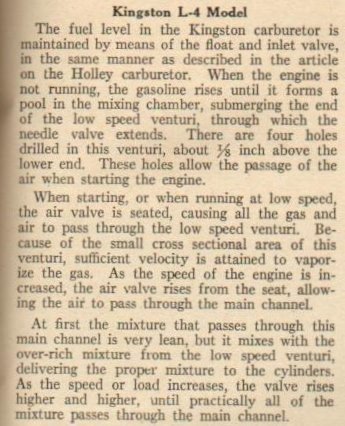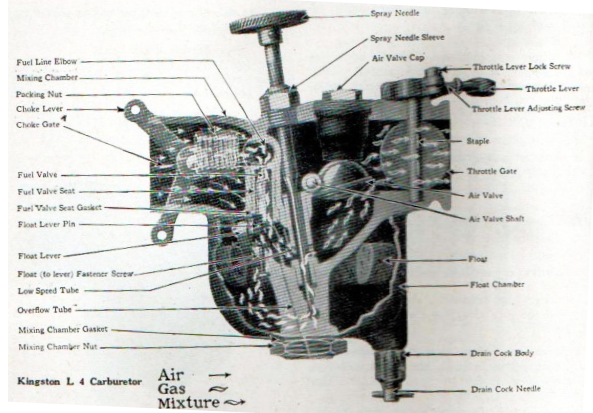Page 1 of 1
The saga of this 1919 Centerdoor and Kingston carb...
Posted: Wed Aug 14, 2024 8:16 pm
by Marshall V. Daut
...continues. 'Sorry, but more advice is requested.
Thanks to MTFCA regular reader Frank Brandi, I have been supplied with a good float for this nightmare Kingston L-4 carb that I am trying to make work on this amateur restoration. I followed the information and photos in the MTFCA carburetor booklet while going through this carb. It has fewer internal parts than a baseball, yet for some reason I can't get it to work. The plugs are firing, so I know we've got power from the timer to the plugs. I removed the spark plugs to check compression, which is good. While the plugs were out and the carb off, we put a little gasoline into each cylinder, replaced the plugs, hooked up their wires. While the owner activated the starter with the ignition key on, I held my hand over the open intake manifold. Good sucking power. My cupped hand over the back of the
open manifold acted as a choke. The engine fired up and ran for a second. So, I know the problem can be traced to the carb. But what?
I had disassembled the carb to blow out any holes and clean it up a little. I know I put the flapper valve back in properly. The bowl had gasoline in it and it didn't leak or overflow, as it had done previously with a defective float. I am at a loss. What did I do wrong while going through this Kingston L-4? I followed the excellent diagram in Lang's catalog, so I know nothing was left out or is missing. Can anyone here with Kingston carb experience possibly tell me some tricks to make this carb work? It MUST be something simple I have overlooked. I don't have a known good carb of any kind to test on the engine to positively isolate this Kingston as the culprit. It's this Kingston L-4 or nothing.

Marshall
Re: The saga of this 1919 Centerdoor and Kingston carb...
Posted: Wed Aug 14, 2024 9:57 pm
by TRDxB2
Old discussions on L-4 starting issues note 3 variations
https://modeltfordfix.com/repairing-a-k ... el-t-ford/
https://www.mtfca.com/discus/messages/5 ... 1436389602
https://www.mtfca.com/discus/messages/1 ... 1311227031
https://mtfca.com/phpBB3/viewtopic.php?t=26796

- 375880.jpg (78.17 KiB) Viewed 1820 times

- L-4 Carb Diagram.png (456.5 KiB) Viewed 1820 times
---
Assumed L-4 or general instruction
Some detail step by step L-4 repairing instructions at
https://modeltfordfix.com/repairing-a-k ... el-t-ford/
they also show 3 external variations of the L-4
--
From the Model T service manual
Re: The saga of this 1919 Centerdoor and Kingston carb...
Posted: Thu Aug 15, 2024 9:16 am
by Mark Nunn
Do you have a neoprene seal on the fuel inlet? Tim Juhl has a great photo of a collapsed fuel line from overtightening, blocking fuel flow.
Re: The saga of this 1919 Centerdoor and Kingston carb...
Posted: Thu Aug 15, 2024 11:45 am
by Marshall V. Daut
Thanks for the links, info and photos, Frank. I have disassembled this L-4 again, but cannot find those two air bleed holes shown in the two photos posted by Corey Walker in 2022. I used a strong light and poked around with a bent safety wire piece. No holes. I have attached the Walker photos, showing wires leading into these holes that I can't find. The inside of this carb is very clean after a thorough glass beading, but I still can find no evidence of air bleeder holes as shown in the two photos. Our L-4 has a brass body with steel bowl, meaning about 1921+. Would that make a difference in whether internal air bleeder holes are present? Perhaps the photos show an earlier version of the L-4 or even the L or L-2? The only air hole I can find is between the fuel inlet port and the throttle opening, externally. It's a short passageway and is clear.
Also, the original info on the Kingston carb says there are four holes drilled in the venturi just above the lower end. Attached is a photo of our carb before the 1st disassembly and cleaning. It looks MUCH better now. Where are those four holes? Can anyone see any problems here?
I am confused because the sources I am using jump around from the L to the L-2 to the L-4. The name plate on this carb was for an L-4 and it has the later oblong-shaped air valve. I just don't know what's going on with this carb and why it won't work. Suggestions?
Mark Nunn - There is no neoprene seal on the fuel inlet. Scratch that one off the list of probable problems.
ADDED: Incidentally, we changed the spray needle to the earlier type for this 1919 Centerdoor. The pictured later '26-27 style had been adapted to this car, complete with fuel mixture rod. Being a brass bodied-L-4, it's unlikely this carb would have appeared on a '26-27 engine as it came to us. It was undoubtedly "retro-fitted" by a previous owner who mixed and matched parts.
Marshall
Re: The saga of this 1919 Centerdoor and Kingston carb...
Posted: Thu Aug 15, 2024 12:04 pm
by Marshall V. Daut
By the way, I am familiar with the Ford manual's carburetor overhaul pages. But the procedure deals overwhelmingly with the Holley NH carb, only obliquely referencing the Kingston. The L-4 is different enough internally that it needs its own overhaul instructions. The MTFCA carburetor manual is helpful to a degree, but leaves several questions unanswered or pictured.
Marshall
Re: The saga of this 1919 Centerdoor and Kingston carb...
Posted: Thu Aug 15, 2024 12:46 pm
by TRDxB2
Marshall V. Daut wrote: ↑Thu Aug 15, 2024 12:04 pm
By the way, I am familiar with the Ford manual's carburetor overhaul pages. But the procedure deals overwhelmingly with the Holley NH carb, only obliquely referencing the Kingston. The L-4 is different enough internally that it needs its own overhaul instructions. The MTFCA carburetor manual is helpful to a degree, but leaves several questions unanswered or pictured.
Marshall
Marshall the link I provided above
https://modeltfordfix.com/repairing-a-k ... el-t-ford/
deals with step by step rebuild instructions for the Kingston L-4
Re: The saga of this 1919 Centerdoor and Kingston carb...
Posted: Thu Aug 15, 2024 1:09 pm
by Marshall V. Daut
Yes, thank you, Frank. That was the very first tutorial I studied a couple weeks ago when I first tackled this L-4 carb. Do you think it would have been helpful to describe which way the flapper valve goes back in? NO source I have studied specified the flapper's orientation, although intuitively the rounded side should face down to match the contour of the carb in this area, flat side on top. Still, little details like this are missing from EVERY source I have looked at concerning Kingstons. All the pieces shown in the tutorial are present in our carb, so I am confident nothing is missing. I am more concerned about overlooking any mysterious passageways that could be plugged. I just reassembled the carb and set the float at the recommended 7/16". I saw nothing wrong or missing during the reassembly, which worries me. Nothing glaring was wrong with the carb when I took it apart yesterday to check out. I fear all I have done is waste time disassembling and re-assembling the carb without fixing a darned thing. Nothing looked out of place or missing. I'll try the carb on the engine again this afternoon, but I have very little confidence it will magically work from yesterday to today without having "fixed" anything out of whack. I want to find the "smoking gun" why this carb doesn't work!!! This Kingston ain't exactly the most complicated carburetor ever made. What am I doing wrong that millions of other Model T owners with Kingstons have done right? Jeez, do I feel stupid today...
Marshall
Re: The saga of this 1919 Centerdoor and Kingston carb...
Posted: Thu Aug 15, 2024 6:48 pm
by Marshall V. Daut
Some success today to report! After disassembling the carb yesterday and finding nothing obviously wrong, I re-assembled it today exactly as I had done before and mounted it on the engine this afternoon. The engine still wouldn't stay running after the gas was used up that we had trickled in each cylinder to encourage the old girl to start. Yesterday I had opened up the spray valve to the recommended 3/4 to one full turn open. Then I went two full turns. Still no pop. Well, after the engine wouldn't stay running again today, just for grins and giggles I opened up the spray valve FOUR full turns - and the engine started up and stayed running. Hurray! It loped a bit, so I went down to three full turns, where it started to die. Up to 3 1/2 turns and the engine liked that setting. I can only surmise that the used spray needle we installed from a different parts carb is worn on its tip, as well as the seat inside the carb body. A mismatch of angles requires three times as many open twists of the spray valve as is normal. We will order a new spray valve and hope that ends this misery. Things look promising.
Thanks for everyone's input. I hope this discussion will help others in a similar predicament with their balky Kingston L-4's. I know I sure learned a lot! (Enough to still prefer the NH design).
Marshall
